Cabomba Caroline - Cabomba caroliniana.
Fluffy beauties
M.CIRLING
St. Petersburg
In almost every aquarium one can see long-stemmed plants with finely dissected leaves. These hydrophytes are necessary for the quick successful launch of any new reservoir. Even in the case when it is supposed to populate the aquarium with freshwater fish without the use of aquatic flora, the short-term, 2-4-week content of such plants in the starting period prepares the water for the long-term safe operation of the reservoir.
This is due to the structure of "feathery" plants and the characteristics of their biology. Finely divided leaves have a large area of assimilating surface. On the one hand, they effectively absorb minerals and carbon dioxide, on the other hand, they emit large amounts of oxygen into water, creating optimal conditions for the functioning of microorganisms and inhibiting the growth of undesirable algae. Due to the presence of these plants, it is possible to maintain biological balance in the old aquarium - the correct mass ratio of organisms of animal and plant origin.
Photo Cabomba Caroline
For an ornamental aquarium, the most interesting may be limnofily and cabombs, as these long-stones are grown rooted in the ground, which allows them to create interesting well-controlled compositions. They perfectly adapt due to the ability to get food from the water throughout the vast surface of the leaves and from the soil due to a well-developed root system.
Plants belonging to both of the above genera, placed in freshly prepared water of the new aquarium, begin to develop fairly quickly, but depending on the light, temperature and hydrochemical conditions, the further fate of the outwardly similar plants will be completely different. I would like to dwell on some comparative characteristics of the conditions for each of the popular species, so that an amateur hobbyist who has the opportunity to choose plants will acquire exactly the kind that can not only be used as a starter, but also successfully grown in an aquarium for a long time.
Perhaps the oldest and most well-known aquarium plants are kabombi and, in particular, (Cabomba caroliniana), common in tropical and subtropical regions of North and South America. Typical for these places quite significant fluctuations in water and air temperature determine some features of the growth of this hydrophyte in aquariums.
Cabomba is familiar to almost all aquarists. It adapts to various conditions, grows rapidly, and actively participates in the circulation of substances in the aquarium. Cabomas are the perfect refuge for fry and are often used as a spawning substrate.
You can grow a plant in aquariums of any size. On a short creeping rhizome, shoots sometimes form up to 1.5-2 or even more meters long. Grows evenly throughout the year. The conditions of detention is undemanding. The acceptable temperature range is from 18 to 28 ° C. Water is preferably mild neutral or slightly acidic. In moderately hard water, kabomba grows more slowly and forms smaller leaves. Alkaline reaction environment for it is destructive.
The purity of the water is very important. In the muddy leaves quickly covered with bloom and decay. In the case of weekly substitution, it is better to limit yourself to small (up to 10%) portions, since the cabomb does not like sharp fluctuations in the physicochemical characteristics of the habitat. This is especially noticeable if the constant temperature of the content is above 24 ° C. Therefore, in older aquariums with a well-established biosystem and a moderate number of fish, kabomba grows better. It should be noted that the presence of viviparous tooth-or small haracin ones contributes to the optimum state of cabombs.

Photo Cabomba Caroline
Lighting can be bright and moderate. With a lack of light, the stem begins to stretch, the whorls are far apart and the leaves become pale in color. The plant does not impose any special requirements on the soil. Neither the nature of the substrate, nor its silting is of great importance. In the new soil under the roots of the plant additional feeding can not be made. It is important to remember that in the substrate consisting of large particles, dense thickets form almost at one point. In soft ground cabomba grows apart. If the water temperature does not exceed 22-23 ° C, mineral dressing cabombe is not needed, because it is enough nutrients coming from food for fish and fresh water. At higher temperatures, plant depletion and gradual degradation can be observed. To stabilize the growth of cabomba, it is desirable to make a mineral supplement, but to choose the right dose correctly is difficult. It is easier to provide the three components of successful cultivation of cabomba: old, relatively cool water and moderately bright lighting.
A few years ago, a garden form of Carolinian cabombs appeared in aquariums - spiral-leaved cabomba (also called twisted or silver) - Cabomba caroliniana "Tortifolia". These plants are quite capricious. When growing them, particular attention should be paid to lighting - bright enough, but not too long, as the plant is very afraid of algal fouling. In addition, the water must be completely clean. The slightest dregs detrimental effect on the condition of the leaves. Adapting a spiral-leaved cabomba in a new aquarium is much more difficult than the natural form, but compliance with the above conditions allows you to successfully cope with this task. The only thing I would like to note is that it is inexpedient to use this plant when starting a new aquarium because of the long period of adaptation and relatively slow growth.
Propagating C.caroliniana and C.caroliniana "Tortifolia" is easy. It is only necessary to remember that you should take the apical stalk longer than 20-25 cm or lower - with a well-developed root system.
Much less likely to grow in aquariums cabombu most beautiful (C.caroliniana pulcherrima), common in the south-eastern regions of North America. It has very beautiful fine, finely dissected leaves from light green to bright cherry red color, depending on growing conditions. The plant can be kept in moderately warm and tropical aquariums at a temperature of from 20 to 28 ° C. Particular attention should be paid to water hardness. The plant receives full development only in very soft water (dGH not more than 4 °). With a stiffness above 6-8 °, the plant becomes shallow, its growth slows down, the stems gradually die off. The active reaction of water is from slightly acidic to neutral. A weekly water change is required, but just as in the previous case, it is best to limit yourself to insignificant volumes or to make a change as often as possible.

Photo Cabomba Caroline
Clean water is one of the most important conditions for the successful cultivation of this plant. Therefore, it is advisable to equip the aquarium with a powerful filter, but not to direct a stream of water to the plant. The flow rate of water around C.caroliniana pulcherrima should be insignificant (the leaves of the plant can vary slightly).
Bright light is needed. Only with properly selected lighting leaves get a red or pink color and sit tight on the stem. When it is deficient, the plants quickly degrade: the leaves become light green and form rare whorls on a long stem. As a source of artificial light is best to use special aquarium or fitolampy. Preference should be given to those whose emission spectrum is as close as possible to the absorption spectrum of chlorophyll. With less success, you can use a combination of fluorescent lamps such as LB or LEC with incandescent lamps.
Light day - no more than 12 hours.
The finest kabombu can be used as an oxygenator plant preparing water in a new aquarium, and as a natural biofilter in an old aquarium, but large plants with a developed root system are more suitable for this. Apical cuttings should be at least 25 cm long. Then they root quickly under favorable conditions and grow very well in fresh water.
No less attractive for aquarists are limnofily. They quite successfully compete in their popularity with cabombs and in some cases grow much better in aquariums. The most common limnofila in recent years has become a sidychaceous (Limnophila sessiliflora). On the one hand, IT is a very undemanding plant with high decorative qualities. On the other hand, the stability of water temperature is one of the necessary conditions for the successful development of limnofila.
Her homeland - Southeast Asia. This region is characterized by the absence of sharp fluctuations in the temperature of the atmosphere and water. In aquariums, where the temperature regime (T = 25–30 ° C), which is constantly maintained for a long time using a thermostat, the limnophil sestotsvetkovaya grows very quickly, is selected. A brief decrease in temperature the plant endures without visible damage. But its growth at the same time is inhibited for quite a long time. I want to draw the reader's attention to the fact that the cabomb is much less sensitive to a short-term decrease in temperature. Thick bright green thickets of limnofily, reaching the surface of the water, form a very beautiful carpet. In the aquarium, planted in the background, limnofila grows dense clumps. It should be noted that the rhizome of the plant develops very quickly and young vertical shoots appear first at a close distance from the mother plant, and then they can cover the entire bottom of the aquarium. Water hardness is desirable from 4-6 to 16 °. In very soft water it is not always possible to achieve growth stability. Regular water changes have a beneficial effect on a limnofil. It is better when the substitution is carried out 2-3 times a week in the amount of 15-20%. The nature of the lighting significantly affects the appearance of the plant. With a lack of light, the stems are drawn out, the whorls of the leaves are reduced, the tops brighten and shallow.
But it should be noted that the limnophile is more easily tolerated shading than any of the above cabomb. In bright light household fluorescent lamps, the plant becomes dense, brightly colored. But only with solar lighting and the use of special aquarium lamps, the plant reaches its maximum size, and the tops at the surface of the water become reddish-brown in color. Another peculiarity of the limnophila sessaceous flower is the ease of reproduction. You can get a new plant from almost any size apical cutting and 10-15 cm intermediate. At the same time, the growth rate of a young plant planted in the ground is a record one. Because of this, the limnophil is excellent for preparing water and stabilizing the biological balance in an aquarium.
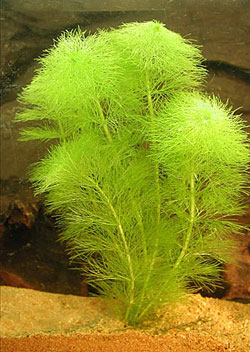
Photo of Limnophila aquatica
The most magnificent representative of the peristisolist group of dwarf plants can be safely called ambulia, or aquatic limnophila (Limnophila aquatica). It looks especially attractive in the background of a high aquarium and in a pool with a large mirror of water. Am-bulia forms dense open-air thickets of bright green color. Mutation of fine finely dissected leaves are more than 15 cm in diameter. The plant is relatively unpretentious and widespread among aquarists. It is better to grow it in a large volume container. Ambulia is thermophilic. At temperatures below 22 ° C growth almost stops. Water hardness does not matter much. Active reaction - close to neutral or weakly acid. Sharp fluctuations in water parameters (temperature, pH, chemical composition) adversely affect the condition of plants. Regular water changes in the amount of 15 to 25% stimulate growth. But a strong current of water in the aquarium can inhibit the development of ambulia.
Lighting should be bright. With a lack of light, the stems begin to stretch, and the whorls of leaves decrease in diameter. Reduction of daylight hours to 10 hours or less (with insufficient brightness) leads to degradation of the tops and the death of the whole plant. Ambulia's diffused sunlight is very helpful. In the winter, it is possible to grow ambulia in a pond in natural light with additional artificial lighting almost without problems. As a source of artificial light, you can use special aquarium lamps or a combination of fluorescent lamps and incandescent lamps. The total duration of daylight hours is at least 10-12 hours. It should be noted that with a light bottom of more than 14 hours, rapid reproduction of algae begins, which are absolutely destructive for thin and delicate leaves. Ambulia in aquarium conditions are propagated by stalk cutting. For greater success, you should take part of the rhizome with a young shoot or just an apical stalk not less than 15 cm long. The stalk, regardless of the presence of the roots, is immediately planted in the ground, not leaving to float. Separated middle parts of the stem can form lateral shoots if the cutting is placed under the same conditions as the parent plant. All manipulations with ambulia should be done very carefully, as the leaves and stems of the plant are tender and afraid of rough contact. Ambulia is usually not used as a starter plant in a new aquarium, since it can hardly be called undemanding. When changing conditions, it takes quite a long time to stabilize its state. But as a regulator of biological equilibrium in the old aquarium and the natural limnofil biofilter water is very effective.
An attentive reader, of course, noticed the differences in the conditions of the contents of the above-described hydrophytes. And really - to combine them in one reservoir is quite problematic. This must be taken into account, especially when starting a new aquarium, when it is important to select aquatic plants so that their adaptation period is minimal and biological balance is established as soon as possible.
The magazine Aquarium 2001 №1
In this article I would like to talk about the Carolina cabomba, which is quite widespread in aquariums. It gained its popularity due to its ability to adapt well to conditions, rapid and uniform year-round growth, and active participation in the circulation of substances in the aquarium. About where it came from, how it is used in an aquarium and how to care for this plant and will be discussed.
The homeland of Cabomba caroliniana is North and South America. Its lush thickets can be found in various reservoirs: standing and flowing, slowly and rapidly, but with a bottom no deeper than one and a half meters.
Cabomba in the aquarium
 For cultivation suitable aquarium of any size. The most advantageous kabomba will look in the middle, in the corners and in the background. Moreover, the lush thickets, the more interesting they look, filling the aquarium with bright, rich openwork greens. Lovely duet work with the Canadian.
For cultivation suitable aquarium of any size. The most advantageous kabomba will look in the middle, in the corners and in the background. Moreover, the lush thickets, the more interesting they look, filling the aquarium with bright, rich openwork greens. Lovely duet work with the Canadian.
Not only beauty is important, but also the other roles of cabombo:
- is a refuge for fry;
- serves as a substrate for spawning;
- takes part in the circulation of substances in the aquarium: absorbs harmful substances from the water, purifies the water, attracting suspended particles to itself.
The only problem may be the maintenance of large fish in aquariums with Cabomba caroliniana, as they provoke the fall of the leaves with their movements.
If you prefer chic undergrowth, it is better to stop the choice on small fish, for example, etc.
What does a karomba look like?
This perennial plant is distinguished by the following features:
Stem long, thin, upright, weakly flowing. At the surface of the water begins to creep.
Leaves located on an underwater stem opposite or three leaves in a whorl. They have a finger-cut sheet plate in the shape of a fan with long thin segments. Upper leaves - floating, whole, arranged alternately. All leaves have scapes.
The roots thin, fibrous, underdeveloped, strengthened in the ground.
Flowers solitary, located in the axils of floating leaves.
What conditions should be in the aquarium?
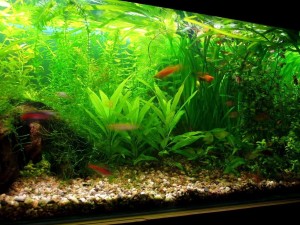 This representative of the family kabombovyh quite undemanding.
This representative of the family kabombovyh quite undemanding.
Aquarium volume can be absolutely anyone.
Water parameters. A moderately warm aquarium with a temperature of 18-22 ° C or a tropical one with more than 24 ° C will be suitable for the plant. The requirement for stiffness - 8, for acidity - 5.5-6.8. In hard water, the plant becomes shallow and loses leaves.
For cabomba, clean water is important, because in muddy water it attracts particles and becomes outwardly unattractive, and if heavily soiled, the leaves may even die. It is necessary to remove sediment in a timely manner and make water changes three or four times a month.
Lighting should be bright, natural or artificial (with the power of fluorescent or incandescent lamps of 0.5 W per 1 liter of volume), with a light day of at least 12 hours. If there is not enough light, then the plant turns yellow, fades and is strongly drawn out in length.
Priming. It is better to use small pebbles and coarse sand, since creeping rhizomes are poorly formed in the coarse coating of the bottom. In old aquariums, the ground is already naturally silted, and such feeding with kabomba is sufficient. When planting plants in the new reservoir contribute at will, but it is not necessary. Dry red clay balls can also be put under the roots.
Cabomba breeding
There are two ways:
Rhizome division
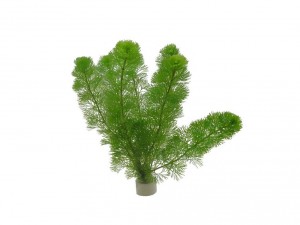 It is important here not to destroy the mother plant, so no more than 30 percent of the creeping rhizomes should be cut off.
It is important here not to destroy the mother plant, so no more than 30 percent of the creeping rhizomes should be cut off.
A sharp knife separates pieces of 2-3 cm. Each piece should have 1-2 buds. They can be left on the surface of the water until the formation of leaves, and then rooted.
Sometimes from the main root grows a new bush. It can be separated, carefully breaking the rhizome, and landed separately.
Stalk cutting
The process is much slower than in the first case. The stem is divided into segments so that each contains 5-6 whorls of leaves.
Parts of the stem are planted in the ground, deepening the lower mutator. About a week later, young roots form.
The upper and lower segments will develop faster than intermediate ones, which do not begin to grow until they have roots.
If the bush has got accustomed, gives new shoots and branches, then it is better not to replant it once again, because the plant does not like it. To begin branching a bush you need to pinch its top.
Important points
- in an aquarium where it is planned to plant a kabomb, there should be a stable biological balance without signs of brown algae, since it is very problematic to clean small leaves from them;
- so that suspended particles do not accumulate on the leaves of Cabomba caroliniana, you will need to install a mechanical filter and do not forget to clean it regularly;
- some mollusks, such as coil, ampulyaria, fiz, like to nibble the delicate leaves of the plant, therefore it is not recommended to keep them together with kabomba;
- if fish are sick in an aquarium and they need treatment, then it should be done in a separate container, since the kabomba does not tolerate drugs (copper sulfate and rivanol) and reacts to them by dropping leaves.
As we can see, caring kabomboy Karolinsky is not so difficult. It is worth making a little effort, and it will delight you all year round with its beauty and benefit your aquarium. Good luck!
Useful video: Karolinsky cabomba - rules of care and reproduction:
Photo can be increased
It grows in quiet bays of rivers and waters of America, from central Brazil to southern Mexico. The main advantages of this plant is relative undemanding to the conditions of detention, which allows it to contain not very experienced aquarist. And originality - it looks like a bushy bush. Photos of various variants of this plant are located on the left.
It grows as a bush, an ornamental plant, with dense fleshy stems and fan-shaped pinnate bright green leaves. Even in small aquariums shoots can reach up to 2 meters in length. If necessary, the lower part of the stalk of the cabomba can be pressed with a stone, although it is usually planted in the ground. Coarse sand is preferred. A large amount of organic matter in the soil is not required, as the cabomba receives most of the nutrients from the water with the help of finely divided leaves. This plant requires good lighting, with a lack of natural light, artificial light should be used. Prefers soft water, preferably not higher than 6 °. It grows well at a water temperature of 23-27 ° C, allows a temporary decrease to 18 ° C. Under optimal conditions, it grows well throughout the year. The conditions of the plant is quite undemanding.
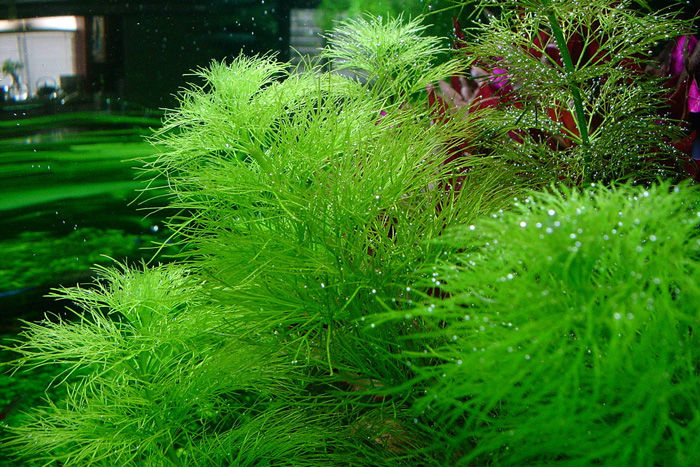
photo can be increased
To achieve branching escape, and get a more dense bush, you need to nip off the top of it. For reproduction, the vegetative method is usually used, the long shoot is cut into pieces, so that each one has thin white roots. Plant cuttings should be so that the soil was 2 - 3 leaves. It is better to plant the plant immediately to a permanent place, as it does not like frequent transplantation. Cabombe can bloom, usually it happens in spring, with increasing daylight hours. The flowers are small, yellowish, grow one at a time on a long pedicle. Bloom above water, at a height of several centimeters. But seed multiplication is not used.
Kabomba is an excellent ornamental plant. In large aquariums it is better to place it at the back wall, where it forms a magnificent openwork curtain, in small ones - in separate groups at the corners. The plant serves as a good haven for live-bearing fry and can be used as a shelter for their childbirth. It is possible to use as a substrate for spawning frenulating fish, including in vessels without soil. But for a long time in such a situation the plant will not be able to exist.
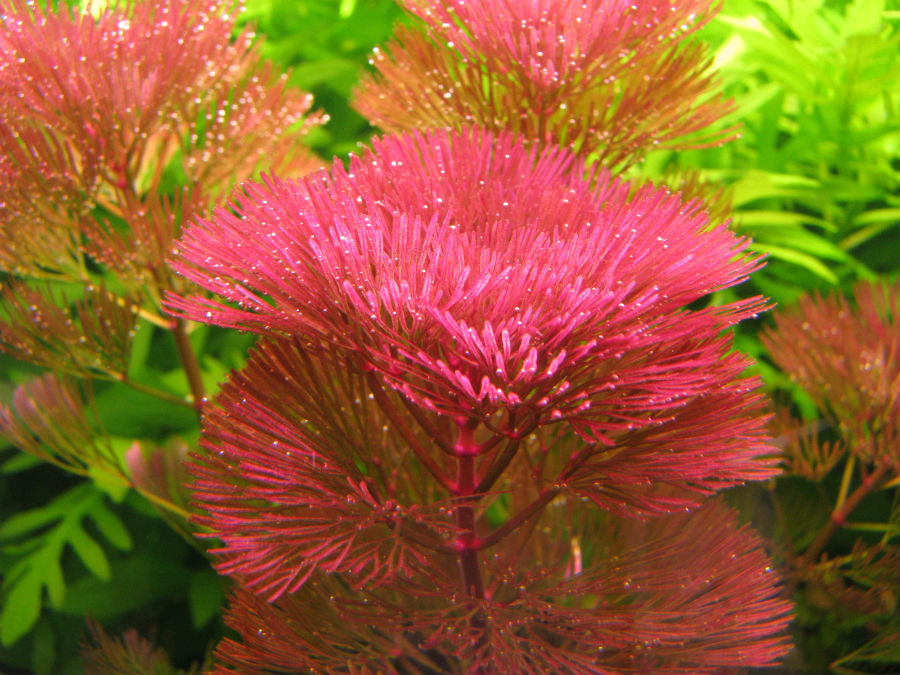
photo can be increased
Cabomba is demanding for clean water. With fish digging the ground poorly compatible, or in this case requires intensive filtration of water. In dirty water, it precipitates particles of turbidity on the surface of the leaves and not only loses its attractiveness, but it can also die rather quickly. It is recommended to replace 25% of the water in the aquarium once a week.
There are several varieties of this plant. For example, such as kabomba Karolinskaya and kabomba beautiful. The first is more unpretentious and prefers cool water at 18 - 22 ° C. The leaves on her bottom side are lighter than the top. The second is more thermophilic, prefers a temperature of 20 - 28 ° C. It has a more developed root system and requires planting in the soil with a thickness of at least 5 centimeters. In addition, it also requires enough soft water, with a hardness of not more than 5 °.
Cabomba Caroline
A very popular aquarium plant, due to its beautiful appearance, especially the "marble" variety of Caroline kabomba. It adapts well to different conditions, grows rapidly, and actively participates in the circulation of substances in the aquarium. Stems reach a length of up to 50 cm. In young plants, leaves are paired, opposite, with age, 3 leaves can form in the whorl. Underwater leaves are forked, divided, rounded, in one sheet up to 50 segments. From the upper side the leaves are pale green, from the lower side are reddish-brown, the young side branches are bright crimson, but subsequently their coloring is restored. Having formed underwater leaves, more powerful plants develop floating, heart-shaped elongated forms, smooth from the upper side, with a waxy coating.
It can be kept in a moderately warm aquarium at a water temperature of 20-25 ° C. Kabomba loves clean water. In the cloudy water, it collects parts of dregs and loses its attractiveness. If the sediment is not removed in time, the old leaves will quickly die. Water in the aquarium should be changed regularly 3-4 times a month. Prefers water of hardness less than 8 °, with a neutral or weakly acid reaction pH 5.5-6.8. It can be taught to more hard water, but then it grows more slowly, and its leaves become smaller. In addition, in such water at the kabomba often grow points die. In hard water from cabomba it is difficult to achieve stable growth for a long time. Therefore, in older aquariums with a well-established biosystem and a moderate number of fish, kabomba grows better. Lighting should be strong enough. With a lack of light, the kabomba begins to be drawn out; its color becomes faded, becomes yellowish and may die. The duration of daylight hours is at least 12 hours.
The root system consists of a set of thin roots. The soil is preferably nutritious, enriched with fertilizer clay. Cabomba loves a lot of nutrients. When planting, the root system should not be buried completely in the ground, in order to avoid rotting. The root system of the kabomba is gentle, but sufficiently developed, therefore, it is better to use sand and small pebbles as a substrate. In the soil, consisting of large particles, creeping rhizome develops worse. In the old aquarium, the plant is enough to feed the natural silting of the soil. Mineral dressing specifically for cabomba can not make, because it is enough of the nutrients coming from food for fish and fresh water.
You can grow this plant in an aquarium of any size. It is better to have it in the background, where it forms a magnificent openwork curtain. The most decorative effect is achieved when growing up in groups. When buying cabombs, make sure that the plants are green, resilient, odorless and mucus. Cabing cabomba is not suitable for disembarkation. Having bought a bunch of plants, cut it 2.5 cm below, then remove the lower leaves from the stems and press the bundle firmly into the ground, then they will get stronger quickly and will grow well in a layer of gravel 5-7 cm thick. It grows by 5-8 cm in Week. Does not tolerate transplants, re-pruning and CO2 deficiency. The least whimsical of all Cabomba species, however, can be a problem in poorly lit aquariums. In this case, try using Limnophila sessiliflora, which requires less light.
Kabomba propagated by cutting the stem or rhizome. Whole stalks of cabomba, separated from the rhizome or with a piece of it, very soon begin to grow in a new place. By dividing the stems into parts with 5-6 whorls of leaves, you can also get new plants, but this process is rather slow. The lower part of the stem with the roots, as well as the apical stalk, begin to grow somewhat faster than intermediate cuttings, which stop growing before the formation of the root system.
Kabomba is the most beautiful
Kabomba finest grows in stagnant and slow-flowing water bodies in the south-east of North America. It has a long, straight, not very branching reddish stem, which, as it reaches the surface of the water, spreads along it, forming floating leaves. The leaves are petiolate plants, located oppositely and colored, from olive-green to purple above and reddish below. The shape of the underwater leaves is palmately dissected, up to 8 cm wide; the form floating on the surface is alternate, integral about 3-4 cm long. In the nodes of these leaves one purple flower is formed.
Cabombu the most beautiful plant in the middle and background in moderately warm and tropical aquariums. Due to the dissected form of the leaves, the plant very well nourishes the water with oxygen, purifies it, and is also well suited for spawning and as a shelter for fry of various species of aquarium fish.
Kabomba is the most demanding to the conditions of detention: special attention should be paid to water hardness, it should not exceed 4 °, otherwise the large leaves of the plant shrink, growth slows down, the stems die off; pH 6-7; water temperature is 20-28 ° C. A weekly substitution of up to 25% of the volume of water is required. Under optimal conditions of kabomba content, the finest grows very quickly.
Kabomba the most beautiful is very demanding on the lighting in the aquarium. Loves bright light. The power of fluorescent lamps should be at least 0.5 W per 1 liter of volume. Directly above the plant it is desirable to arrange an incandescent lamp with a power of 25-40 watts. Also useful is scattered sunlight falling on the aquarium for 1-2 hours per day. With proper lighting, the young leaves of the plant acquire a purple color, while the old leaves retain a reddish color on the underside. With a lack of light - the stem is pulled out, the leaves turn pale and become light green. Light day at about 12 o'clock.
The finest kabomba has a strong root system and needs nutrient soil. It should be sufficiently silted, with a thickness of 5 cm. The substrate can be fine-grained sand or small pebbles. Cabombe the most beautiful does not like frequent transfers. Kabomba reproduces the most beautiful by cutting the stem. To do this, take a piece of the stem with 3 whorls of leaves and immediately planted into the ground or left to float on the surface of the water until the root system.
Kabomba is a wonderful and wonderful plant, capable. For quite a long time, it continues to remain popular in the aquarium culture and, along with vallisneria, is the most popular among enthusiasts of this hobby, being used for planting in home aquariums.
It originally originates from South America, where it grows in water bodies almost everywhere from Mexico to Brazil. A distinctive feature of cabombs - undemanding and unpretentiousness, which makes it appropriate for breeding, even a novice aquarist. In addition, this plant is really beautiful in its own way and externally is a bushy bush with fleshy stems. Kabomba in the aquarium looks organic and good.
What is the best way to plant and care for the plant?
It is best to place cabomba bushes along the walls to create a beautiful background. They are planted in the ground, although in some cases it is recommended to press the stem with a stone. At the same time, being planted in soft soil, cabomb sprawls to the sides. Nutrients Kabomba gets mainly from water, so additional additives in the soil is not required. The plant needs a temperature ranging from 23 to 27 degrees Celsius, however, it can endure for some time and lowered to 18. From this it is easy to conclude that, as an aquarium plant, cabomba is a good choice and does not need any maintenance requiring special care. knowledge.
In order to achieve splendor from a single bush, you can pinch off a piece of the top. In the spring, the kabomba can bloom, with beautiful yellow flowers rising a few centimeters above the surface of the water. Kabomba in the aquarium brings obvious benefits for its inhabitants. Clusters of cabombs can be used as a shelter for fry and small fish, and can also serve as a substrate for spawning. Today, kabombu can be purchased at almost every specialty store.
However, cabomba, like other plants, is divided into several species, each of which has its own distinctive features.
Varieties of this plant family

Cabomba Corolina (Cabomba caroliniana) is an aquarium plant of the Cabombaceae family (Cabombaceae).
Habitat
Natural habitat Caroline Cabombs distributed from North to South America. It grows in stagnant and flowing waters with fast and slow currents, at a depth of one and a half meters.
Appearance
Karolinska Kabomba it is widespread among aquarium lovers. It is a long-stem plant. In she actively participates in the circulation of substances, quickly grows and adapts to almost any environmental conditions. Thick thickets of this seaweed are often used as a shelter by fry, as well as a substrate for spawning some types of aquarium fish . Lovers grow Kabombu, as a rule, in the background of the aquarium, where it plays the role of a wonderful openwork curtain.
Conditions of detention
For cultivation Kabomba Korolinskaya aquariums of any size will do. The cabomba is growing throughout the year. The conditions of detention for the Karolinska Kabomba are of no particular importance, since it is absolutely not demanding. The water temperature in the aquarium can be close to tropical conditions, and reach 24 ºС. But it will not be worse if the temperature level varies between 18-25 ºС. The most optimal level of water hardness is 8º. The pH should be 5.5-6.8. However, the plant can be easily adapted to harder water. True, it will grow more slowly, and the leaves will become smaller. In the polluted environment, particles of dirt and silt adhere to the leaves of Kabomba, and it loses its attractiveness, therefore it is better to keep it in clean, clear water. If time does not change the water, then there is a risk that the leaves covered with dirt, will die. Lighting in the aquarium should be strong. If the cabomb lacks light, it will begin to stretch, and the color will become faded with a slightly yellowish tinge. You can use both natural and artificial light for lighting. The approximate lamp power suitable for a plant should be no more than 0.4–05 W per liter of water. For the duration of a light day should be equal to 12 hours at least. The soil in which Kabomba will grow should be sufficiently nutritious. If you have transplanted a plant in a new aquarium, take care to ensure that the soil was not too large. River sand and small pebbles are best suited. Additional nutritional supplements do not necessarily. Kabomba - unpretentious plant. She often lacks a silty covering of the soil, nutrients that come with fish food and fresh water.
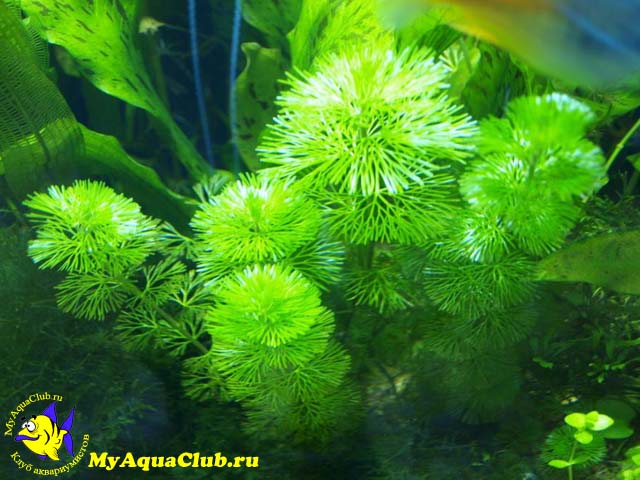
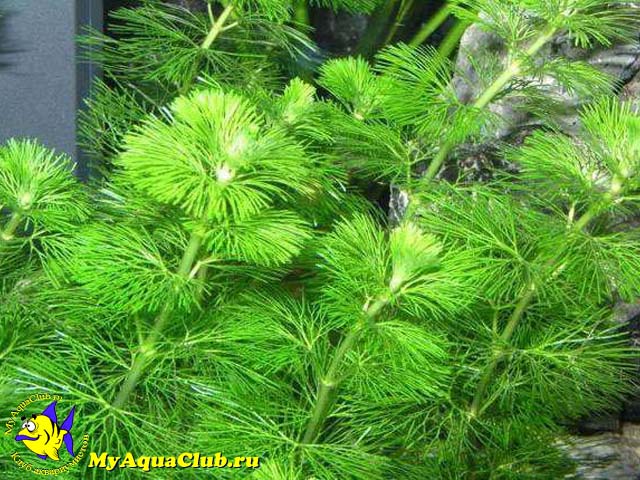
Breeding
As in nature Cabomba Corolina propagated by cutting the stems and rhizomes. Caught in the new place, the stems, separated from the plant with a piece of rhizome, quickly take root and begin to grow. New plants can also be obtained by separating the stems into pieces with 5-6 leaves. But it is quite a long process. Stems with a preserved lower part and root begin to grow immediately, unlike the intermediate parts of the stem, which stop growing until a rhizome is formed.

